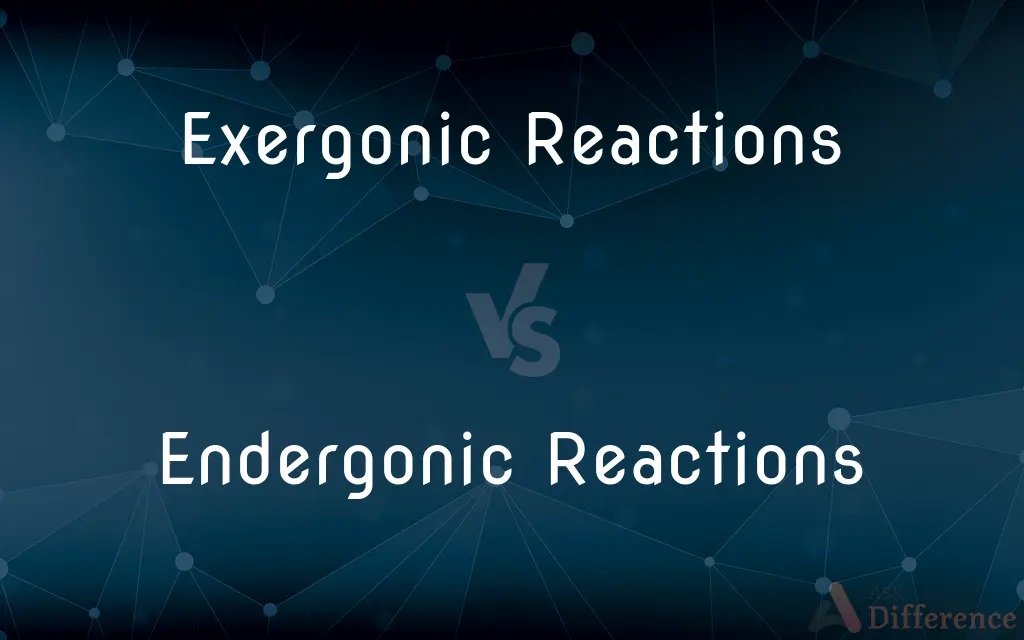Exergonic Reactions vs. Endergonic Reactions — What's the Difference?
Edited by Tayyaba Rehman — By Fiza Rafique — Published on December 10, 2023
Exergonic Reactions release energy, making them spontaneous. Endergonic Reactions require energy input and are non-spontaneous. Both describe energy changes in chemical processes.

Difference Between Exergonic Reactions and Endergonic Reactions
Table of Contents
ADVERTISEMENT
Key Differences
Exergonic Reactions are chemical reactions that result in the release of energy, typically in the form of heat, light, or sound. This release means that they occur spontaneously under specific conditions. In contrast, Endergonic Reactions absorb energy from their surroundings, indicating that they need an external energy source to proceed.
Exergonic Reactions, due to their energy-releasing nature, often manifest as combustion reactions, like the burning of wood or fuel. Endergonic Reactions, on the other hand, are common in biological systems, where energy from the environment, often derived from food or sunlight, drives reactions essential for life.
In terms of Gibbs free energy, Exergonic Reactions have a negative change, implying the system loses energy to the surroundings. Endergonic Reactions exhibit a positive change in Gibbs free energy, denoting that the system gains energy from the surroundings.
Exergonic Reactions tend to proceed quickly because they release energy, making them favorable in nature. Endergonic Reactions, being energy-consuming, usually occur in controlled environments, like within cells, where the necessary energy is readily available.
Understanding Exergonic and Endergonic Reactions is crucial in fields like biochemistry and thermodynamics. While Exergonic Reactions power many processes, Endergonic Reactions sustain life by driving growth and repair in organisms.
ADVERTISEMENT
Comparison Chart
Energy Dynamics
Release energy
Absorb energy
Spontaneity
Spontaneous
Non-spontaneous
Common Manifestations
Combustion reactions
Biological reactions like photosynthesis
Change in Gibbs Free Energy
Negative
Positive
Speed of Reaction (generally speaking)
Tend to proceed quickly
Tend to be slower and need energy input
Compare with Definitions
Exergonic Reactions
Exergonic Reactions are thermodynamically favorable due to energy discharge.
Many natural processes are driven by Exergonic Reactions due to their energy-releasing nature.
Endergonic Reactions
Endergonic Reactions consume energy during the process.
Photosynthesis is an Endergonic Reaction as it requires energy from sunlight.
Exergonic Reactions
Exergonic Reactions often occur without external energy input.
When wood burns, the Exergonic Reaction takes place without the need for added energy.
Endergonic Reactions
Endergonic Reactions are chemical reactions with a positive Gibbs free energy change.
The synthesis of proteins in cells is an example of an Endergonic Reaction.
Exergonic Reactions
Exergonic Reactions are spontaneous chemical events with a negative change in Gibbs free energy.
The breakdown of glucose in cellular respiration is an Exergonic Reaction.
Endergonic Reactions
Endergonic Reactions are non-spontaneous and need an energy source to proceed.
Many biochemical reactions in our bodies are Endergonic, relying on energy from food.
Exergonic Reactions
Exergonic Reactions are processes that result in the release of energy.
Combustion is an Exergonic Reaction because it releases heat and light.
Endergonic Reactions
Endergonic Reactions increase the system's energy content.
Building complex molecules in organisms typically involves Endergonic Reactions.
Exergonic Reactions
Exergonic Reactions decrease the system's energy content.
The explosion of dynamite is an Exergonic Reaction, causing a sudden decrease in the system's energy.
Endergonic Reactions
Endergonic Reactions capture energy from their surroundings.
Plants capture sunlight and convert it into chemical energy through Endergonic Reactions.
Common Curiosities
What's an example of an Exergonic Reaction?
Combustion, like burning wood, is a classic Exergonic Reaction.
In terms of Gibbs free energy, how do the reactions differ?
Exergonic Reactions have a negative change, while Endergonic Reactions have a positive change.
What are Exergonic Reactions?
Exergonic Reactions are chemical reactions that release energy.
How do Endergonic Reactions differ?
Endergonic Reactions absorb energy from their surroundings.
Are Exergonic Reactions always spontaneous?
Generally, Exergonic Reactions are spontaneous because they release energy.
Do Exergonic Reactions always release heat?
Most do, but they can also release energy in other forms like light or sound.
Can an Endergonic Reaction occur without an energy source?
No, Endergonic Reactions always require an energy input.
Why are Endergonic Reactions crucial in biology?
They drive essential processes like growth, repair, and energy storage in organisms.
Do Endergonic Reactions need external energy to proceed?
Yes, Endergonic Reactions require an external energy source.
How about an example of an Endergonic Reaction?
Photosynthesis, where plants absorb sunlight to create glucose, is an Endergonic Reaction.
Share Your Discovery

Previous Comparison
EEPROM vs. EPROM
Next Comparison
Sneakers vs. TrainersAuthor Spotlight
Written by
Fiza RafiqueFiza Rafique is a skilled content writer at AskDifference.com, where she meticulously refines and enhances written pieces. Drawing from her vast editorial expertise, Fiza ensures clarity, accuracy, and precision in every article. Passionate about language, she continually seeks to elevate the quality of content for readers worldwide.
Edited by
Tayyaba RehmanTayyaba Rehman is a distinguished writer, currently serving as a primary contributor to askdifference.com. As a researcher in semantics and etymology, Tayyaba's passion for the complexity of languages and their distinctions has found a perfect home on the platform. Tayyaba delves into the intricacies of language, distinguishing between commonly confused words and phrases, thereby providing clarity for readers worldwide.
















































